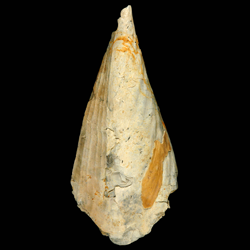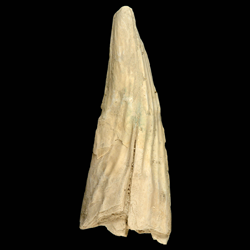
Pinnidae

Overview
Common name: Pen shells or fan shells
Key morphological features: The Pinnidae range in size up to ~900mm. The shells are thin, dully colored, flexible (brittle when dried), and equivalve. The shells are long and trigonal in outline with a small anterior gape through which the byssus threads pass and a much larger ventral gape. The shell is composed of a combination of aragonite and calcite and has a high organic content. Pinnid shells can be smooth or have short, small spines on the exterior, usually also exhibiting broad radial undulations. Valve interiors lack a pallial line and have smooth interior shell margins, and an anterior nacreous layer between the posterior adductor muscle and the umbo. The shape of this nacreous layer is taxonomically diagnostic. The anterior end of Pinnidae shells also often exhibits septa. Species of Pinnidae are heteromyarian, with the posterior adductor muscle much larger than the anterior. The posterior adductor muscle scar is centrally located, whereas the anterior adductor muscle scar is at the pointed, anterodorsal end of the shell. The hinge is long, straight, and edentate. Source: Mikkelsen, P.M., and Bieler, R. 2008. Seashells of Southern Florida: Bivalves. Princeton, New Jersey: Princeton University Press. 503 pp.
Geological range: Carboniferous to Recent (Mikkelsen & Bieler, 2008).
Geographic distribution: A distributional map for modern Pinnidae may be accessed from OBIS. A distributional map for ancient Pinnidae may be accessed from the Paleobiology Database.
Diversity: There are 58 recognized living species of Pinnidae and 4 genera (WoRMS database, unvetted). The Paleobiology Database recognizes 10 fossil genera and 182 fossil species of Pinnidae (unvetted).
Paleoecology: The Pinnidae are endobyssate, marine, filter-feeding bivalves and include some of the largest extant species of bivalves. They live with the pointed, anterior ends of their shells embedded in sediment and the broader, gaping posterior sticking up above the sediment-water interface. Exposed portions of the shells are often heavily encrusted and bored by epi- and endobionts. The Pinnidae can be found worldwide in shallow tropical and subtropical waters. Source: Mikkelsen and Bieler (2008).
Phylogenetic status: Monophyletic. The recent molecular phylogenetic analysis by Lemer et al. (2014) supports the monophyly of Family Pinnidae.

